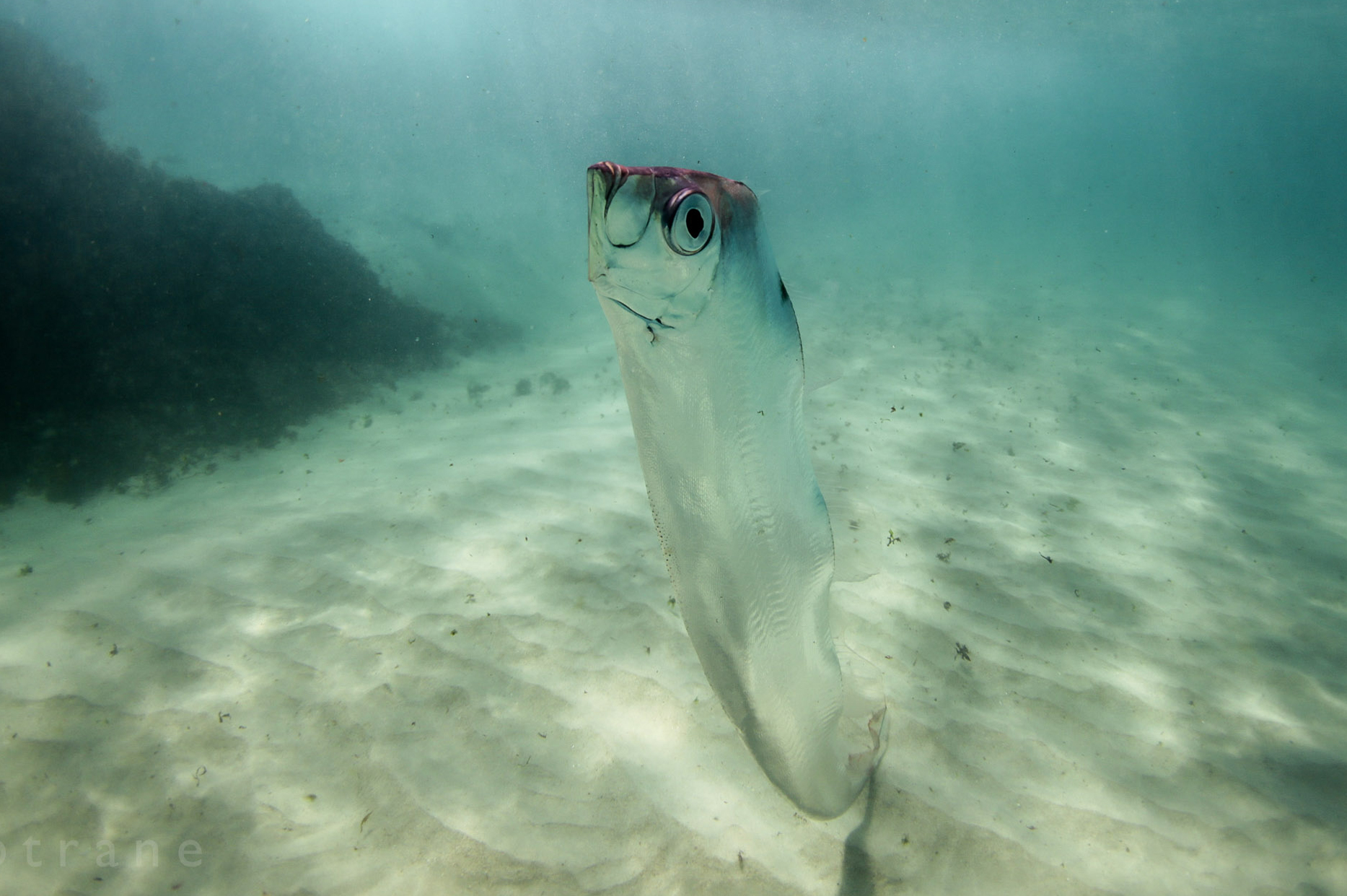- Classification
- ACTINOPTERYGII
- LAMPRIDIFORMES
- TRACHIPTERIDAE
- Trachipterus
- jacksonensis
Southern Ribbonfish, Trachipterus jacksonensis (Ramsay 1881)

A Southern Ribbonfish, Trachipterus jacksonensis, about 30 m offshore from Whites Beach, Broken Head, New South Wales. Source: Stewart Barry / Atlas of Living Australia. License: CC by Attribution
Large oceanic fishes with brilliant silvery skin and bright red fins. Southern Ribbonfish have a long, compressed body that tapers to a very narrow tail base, large eyes, a large very protrusible mouth, and a long-based dorsal fin extending from the top of head with a high crest at the front in young. Juveniles have a large red caudal fin, and long, fan-like pelvic fins that reduce with growth to become small tubercles in adults. They also have several large black blotches or spots on the side: usually 3-4 above the lateral line, and 1-2 below.
Southern Ribbonfish occasionally enter coastal bays.
Although some authors referred to this species as Trachipterus jacksonensis, Clark's description was published before that of T. jacksonenesis (April 1881 vs May 1881).
Video of a Southern Ribbonfish in Port Phillip, Victoria, October 2017.
Video of a juvenile species of Trachipterus (not a Southern Ribbonfish).
Southern Ribbonfish, Trachipterus jacksonensis (Ramsay 1881)
More Info
|
Distribution |
Known in Australian waters from Off Southport, Queensland to Port Lincoln, South Australia and off Bunbury, Western Australia. Because of confusion over the two species found in Australian waters, some distribution records may not be reliable. Elsewhere the species is southern circumglobal in temperate waters except South America. |
|
Features |
Dorsal fin 145-185; Caudal fin 8 + 5; Pectoral fin 9-11; Pelvic fin 5; Gill rakers (lower limb) 10; Vertebrae 81-83. Body long, very compressed, deep anteriorly, tapering to a very narrow tail base; eyes large, mouth very protrusible; dorsal fin long-based, extending from top of head to tail, with a high crest at the front in young, crest reducing in size and finally lost with growth; pelvic fins long and fan-like in juveniles, reduced to small tubercles in adults; anal fin absent. |
|
Size |
To 2.2 metres. |
|
Colour |
Body silver, partly transparent; juveniles with several large black blotches on either side, usually 3-4 above lateral line, 1-2 below; fins bright red. |
|
Feeding |
Feeds mostly on pelagic fishes, crustaceans and squids. |
|
Fisheries |
These fishes are most often taken in deepwater trawls, but are occasionally sighted at the ocean surface or found stranded ashore after storms. |
|
Etymology |
The specific name refers to the type locality: Port Jackson, New South Wales. |
|
Species Citation |
Regalecus jacksonensis Ramsay 1881, Proceedings of the Linnean Society of New South Wales 1 5(4): 631, pl. 20. Type locality: Manly Beach, New South Wales. |
|
Author |
Bray, D.J. 2021 |
|
Resources |
Southern Ribbonfish, Trachipterus jacksonensis (Ramsay 1881)
References
Clarke, F.E. 1881. Description of a new species of Trachypterus. Transactions and Proceedings of the New Zealand Institute 13(21): 195-199 [as Trachypterus arawatae] See ref at BHL
Fitch, J.E. 1964. The ribbon fishes (family Trachipteridae) of the eastern Pacific Ocean, with a description of a new species. California Fisheries and Game 50(4): 228-240 figs 1-5.
Glover, C.J.M. 1994. Families Lampridae, Veliferidae, Lophotidae, Trachipteridae, Regalecidae, Fistulariidae. pp. 427-435 figs 382-387 In: Gomon, M.F., Glover, C.J.M. & Kuiter, R.H (eds) The Fishes of Australia's South Coast. Adelaide : State Printer 992 pp. 810 figs (as Trachipterus arawatae)
Grant, E.M. 1975. Guide to Fishes. Brisbane : Queensland Government, Co-ordinator General’s Department 640 pp. (p. 117, as Trachipterus jacksonensis)
- Heemstra, P.C. & Kannemeyer, S.X. 1986. Trachipteridae. p. 399-402. In Smith, M.M. & P.C. Heemstra (eds) Smiths' sea fishes. Springer-Verlag, Berlin.
- Johnson, J.W. 1999. Annotated checklist of the fishes of Moreton Bay, Queensland, Australia. Memoirs of the Queensland Museum 43(2): 709-762
Martin, J.M. & Hilton, E.A. 2021. A taxonomic review of the family Trachipteridae (Acanthomorpha: Lampridiformes), with an emphasis on taxa distributed in the western Pacific Ocean. Zootaxa 5039(3): 301–351 https://doi.org/10.11646/zootaxa.5039.3.1
May, J.L. & Maxwell, J.G.H. 1986. Field Guide to Trawl Fish from Temperate Waters of Australia. Hobart : CSIRO Division of Marine Research 492 pp. (as Trachipterus arawatae)
McCoy, F. 1889. Prodromus of the zoology of Victoria; figures and descriptions of the living species of all classes of the Victorian indigenous animals. Government Printer, Melbourne. Decade 13: Pl. 122, 83-84 (as Trachipterus taenia). See ref. at BHL
Moore, J. 2019. Trachipterus jacksonensis . The IUCN Red List of Threatened Species 2019: e.T123376283A123376548. http://dx.doi.org/10.2305/IUCN.UK.2019-2.RLTS.T123376283A123376548.en. Downloaded on 08 January 2020.
Ramsay, E.P. 1881. On a new species of Regalecus from Port Jackson. Proceedings of the Linnean Society of New South Wales 1 5(4): 631-633 fig. 20 (as Regalecus jacksonensis) Ref at BHL
Roberts, T.R. 2012. Systematics, biology, and distribution of the species of the oceanic oarfish genus Regalecus (Teleostei, Lampridiformes, Regalecidae). Mémoires du Muséum National d'Histoire Naturelle, Paris (N. S.) (Série A) Zoologie : 202: 1-268.
Scott, E.O.G. 1983. Observations on some Tasmanian fishes. Part 29. Papers and Proceedings of the Royal Society of Tasmania 117: 167-202 figs 1-6 pls 1-3 (as Trachipterus arawatae, in part)
Stewart, A.L. 2015. 93 Family Trachipteridae. pp. 689-693 in Roberts, C.D., Stewart, A.L. & Struthers, C.D. The Fishes of New Zealand. Wellington : Te Papa Press Vol. 3 pp. 577-1152.
Whitley, G.P. 1964. A survey of Australian Ichthyology. Proceedings of the Linnean Society of New South Wales 89(1): 11-127









